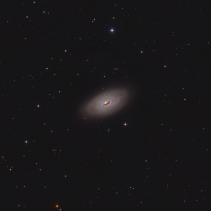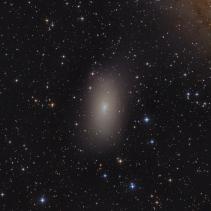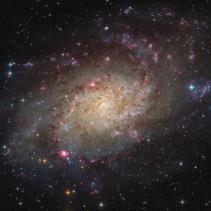Galaxies
M 64
The Black Eye Galaxy (also called Evil Eye Galaxy; designated Messier 64, M64, or NGC 4826) is a galaxy which was discovered by Edward Pigott in March 1779, and independently by Johann Elert Bode in April of the same year, as well as by Charles Messier in 1780. It has a spectacular dark band of absorbing dust in front of the galaxy's bright nucleus, giving rise to its nicknames of the "Black Eye" or "Evil Eye" galaxy. The galaxy is also called the Sleeping Beauty galaxy. M64 is well known among amateur astronomers because of its appearance in small telescopes. It is a spiral galaxy in the Coma Berenices constellation.
L = 8 * 1800 sec. bin1, RGB = 9 * 900 sec. bin2, Ha = 12 * 1800 sec. bin2, OIII = 8 * 1800 sec. bin2
Total exposition - 21 hours.
Pixinsight 1.8 and Photoshop.
M 110
Messier 110, also known as NGC 205, is a dwarf elliptical galaxy that is a satellite of the Andromeda Galaxy. M110 contains some dust and hints of recent star formation, which is unusual for dwarf elliptical galaxies in general.
Although Charles Messier never included the galaxy in his list, it was depicted by him, together with M32, on a drawing of the Andromeda galaxy; a label on the drawing indicates that Messier first observed NGC 205 on August 10, 1773. The galaxy was independently discovered by Caroline Herschel on August 27, 1783; her brother William Herschel described her discovery in 1785. The suggestion to assign the galaxy a Messier number was made by Kenneth Glyn Jones in 1967.
L = 18 * 1800 sec. bin1, R = 11 * 900 sec. bin2, G = 11 * 1000 sec. bin2, R = 11 * 1100 sec. bin2.
Total exposition - 18.2 hours.
Pixinsight 1.8, eXcalibrator, Photoshop.
M 74
Messier 74 (also known as NGC 628) is a spiral galaxy in the constellation Pisces. It is at a distance of about 32 million light-years away from Earth. The galaxy contains two clearly defined spiral arms and is therefore used as an archetypal example of a grand design spiral galaxy. The galaxy's low surface brightness makes it the most difficult Messier object for amateur astronomers to observe. However, the relatively large angular size of the galaxy and the galaxy's face-on orientation make it an ideal object for professional astronomers who want to study spiral arm structure and spiral density waves. It is estimated that M74 is home to about 100 billion stars.
M74 was discovered by Pierre Méchain in 1780. Méchain then communicated his discovery to Charles Messier, who listed the galaxy in his catalog.
L = 17 * 1800 sec. bin1, RGB = 10 * 900 sec. bin2, Ha = 11 * 1800 sec. bin2, n the each filters.
Total exposition - 21.5 hours.
Pixinsight 1.8, Photoshop.
M 33
The Triangulum Galaxy is a spiral galaxy approximately 3 million light-years (ly) from Earth in the constellation Triangulum. It is catalogued as Messier 33 or NGC 598, and is sometimes informally referred to as the Pinwheel Galaxy, a nickname it shares with Messier 101. The Triangulum Galaxy is the third-largest member of the Local Group of galaxies, which includes the Milky Way, the Andromeda Galaxy and about 44 other smaller galaxies. It is one of the most distant permanent objects that can be viewed with the naked eye.
The galaxy is the smallest spiral galaxy in the Local Group and it is believed to be a satellite of the Andromeda Galaxy due to their interactions, velocities and proximity to one another in the night sky. It also has an H-II nucleus.
The Triangulum Galaxy was probably discovered by the Italian astronomer Giovanni Battista Hodierna before 1654. In his work De systemate orbis cometici; deque admirandis coeli caracteribus ("About the systematics of the cometary orbit, and about the admirable objects of the sky"), he listed it as a cloud-like nebulosity or obscuration and gave the cryptic description, "near the Triangle hinc inde". This is in reference to the constellation of Triangulum as a pair of triangles. The magnitude of the object matches M33, so it is most likely a reference to the Triangulum galaxy.
The galaxy was independently discovered by Charles Messier on the night of August 25–26, 1764. It was published in his Catalog of Nebulae and Star Clusters (1771) as object number 33; hence the name M33. When William Herschel compiled his extensive catalogue of nebulae, he was careful not to include most of the objects identified by Messier. However, M33 was an exception and he catalogued this object on September 11, 1784 as H V-17.
L = 19 * 1800 sec. bin1, RGB = 10 * 900 sec. bin2, HaOIII = 11 * 1800 sec. bin2, in the each filters.
Total exposition - 28 hours.
Pixinsight 1.8, Lightroom.




